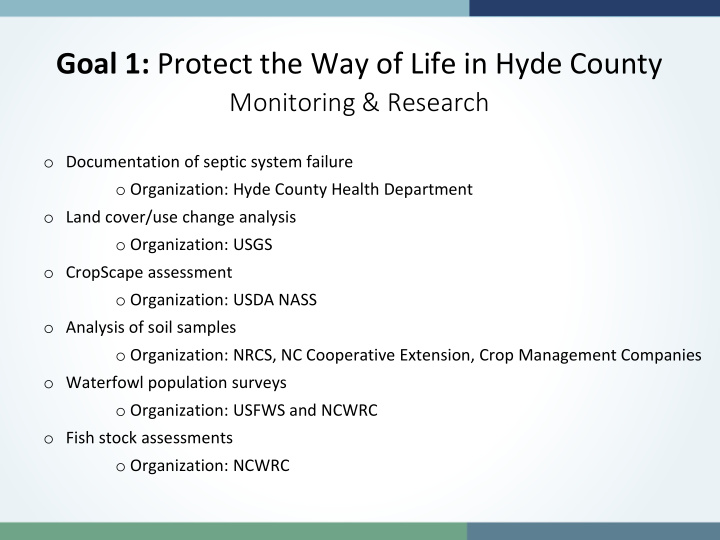



Goal 1: Protect the Way of Life in Hyde County Monitoring & Research o Documentation of septic system failure o Organization: Hyde County Health Department o Land cover/use change analysis o Organization: USGS o CropScape assessment o Organization: USDA NASS o Analysis of soil samples o Organization: NRCS, NC Cooperative Extension, Crop Management Companies o Waterfowl population surveys o Organization: USFWS and NCWRC o Fish stock assessments o Organization: NCWRC
Tracking Changes in Land Use Top Three Land Uses: 1. Woody Wetlands 2. Cultivated Crops 3. Developed Open Space Summary: Minor changes in land use over the last 15 years. No significant changes in developed land or agricultural lands Next Step: Analysis 2016 data set when available; Identify any data for pre-2001 land use.
CropScape Assessment
Annual Mid-Winter Waterfowl Survey
Goal 1: Protect the Way of Life in Hyde County Management Actions to Consider o Institute active lake level management o Upgrade/repair septic systems or connect to centralized sewer o Preserve the agricultural industry o Continue to follow nutrient management plans or alter based on recommendations o Continue to follow or alter herbicide/pesticide application guidelines based on recommendations o Practice no till or strip till where appropriate o Preserve space for growth of filter strips along edges of drainage ditches o Construct sediment basins/settling ponds o Alter water management of croplands (i.e. pump automation) o Perform maintenance dredging on drainage canals and ditches o Consider converting to organic farming practices
Goal 1: Protect the Way of Life in Hyde County Management Actions to Consider o Preserve waterfowl hunting heritage o Alter impoundment water management (i.e. stage drawdowns, pump automation) o Preserve space for growth of filter strips along edges o Construct sediment basins/ settling ponds o Convert impoundments from corn feedstock to MSM units o Preserve recreational fishing heritage o Review and update fishing and crabbing regulations as necessary o Manage tide gates for anadromous/ catadromous fish and larval blue crab passage o Stock fish/ zooplankton
Goal 2: Active Management of Lake Water Level Monitoring & Research o Real-time hydrologic data o USGS monitoring stations o Bell Island Pier station o Weekly lake level and canal flow rate monitoring program o Organizer: USFWS staff- informed the development of the water budget and stage-volume relationship for the lake o Modeling the impact of sedimentation and SLR on the outflow canals o Organizer: Dr. Etheridge, ECU o Lake Level Monitoring Project o Organizer: Dr. Pavelsky, UNC o Sea Level Rise Projections o Organizer: NOAA, NC CRC Science Panel
Goal 2: Active Management of Lake Water Level Management Actions to Consider o Continue monitoring and research efforts o Clean and snag canals where appropriate o Keep tide gates free of debris o Replace flap gates with side gates where appropriate o Perform maintenance dredging of internal lake canals and outlets, if advisable o Consider beneficial use of dredge material to construct emergent vegetation zones or maintain earthen dikes o Perform temporary drawdowns to increase storage capacity o Consider use of pumps to manage lake level and water diversion o Conduct localized hydrological studies o Consider excavating an additional outlet canal o Re-delineate existing service districts and drainage associations o Establish a drainage district for the watershed
Goal 3: Restore Water Quality Monitoring & Research o Continuous water quality monitoring of pH, DO, turbidity, temperature, and salinity in lake and weekly monitoring in canals o Organizer: USFWS & USGS o Monthly monitoring of nutrients, suspended sediment, and chl- a o Organizer: USFWS & NCDWR o Phytoplankton and cyanotoxin community assessments o Organizer: USFWS o Nutrient bioassays and sediment nutrient flux analysis o Organizer: Dr. Piehler, UNC o Impact of waterfowl impoundments o Organizer: Dr. Etheridge, ECU
Water Quality Monitoring Results
Goal 3: Restore Water Quality Monitoring & Research o Annual SAV coverage survey o Organizer: USFWS staff o SAV planting experiment o Organizer: Dr. Piehler, UNC o Assessing the risks of agricultural herbicides o Organizer: Anna Alicea and Dr. Greg Cope, NCSU; Celeste Journey, USGS o Carp biomass removal feasibility study o Organizer: April Lamb, Dr. Fischer, and Dr. Layman, NCSU o Modeling nutrient dynamics in Lake Mattamuskeet o Organizer: Dr. Obenour and Dr. Del Giudice, NCSU
Annual SAV Survey: 1989 - 2017
Goal 3: Restore Water Quality Management Actions to Consider o Continue monitoring and research efforts o Preserve space for growth of filter strips along edges of drainage ditches o Construct woodchip bioreactors o Construct sediment basins/settling ponds o Sheet flow water over wetlands o Perform temporary drawdowns to facilitate sediment deposition o Perform temporary drawdowns to re-establish emergent zones o Plant emergent marsh grasses o Plant SAV o Alter herbicide applications on croplands if advisable
Goal 3: Restore Water Quality Management Actions to Consider o Alter impoundment water management (i.e. stage drawdowns, pump automation) o Convert impoundments from corn feedstock to MSM units o Perform common carp biomass removal o Mechanical o Chemical o Stock fish/zooplankton o Consider coagulation and flocculation treatment system
Recommend
More recommend